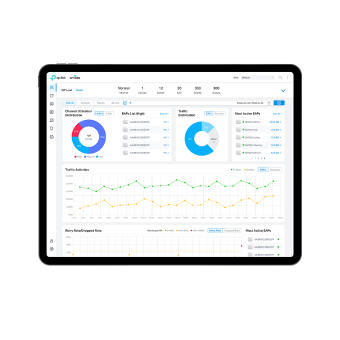How to Optimize Online Identification of VIGI and Third-Party Cameras in Omada Central
Contents
Identification Mechanism of VIGI Cameras in Omada Central
Comparison Between VIGI and Third-Party Cameras
How to Accelerate Camera Identification
Objective
This article explains the mechanisms behind the online detection and recognition of camera devices and provides methods to enhance the speed of discovering security terminal devices.
Requirements
- Omada Central
- VIGI Cameras & Third-Party Cameras
Identification Mechanism of VIGI Cameras in Omada Central
The identification and detection process in Omada Central consists of two main steps:
Step 1. Identification of Security Terminal Device Type
1. The switch captures and identifies specific keywords from ONVIF protocol messages and reports the results to Omada Central.
2. If the device type cannot be determined via ONVIF, the switch analyzes traffic patterns to infer the device type and reports it to Omada Central.
Note: There are preconditions for using the traffic identification method. The IPC needs to be managed by the NVR and needs to operate normally for 20 to 30 minutes.
3. If the previous methods fail, Omada Central attempts to identify the device by checking its hostname for "IPC" or "NVR."
Step 2. Determination of VIGI camera
1. Omada Central analyzes LLDP (Link Layer Discovery Protocol) data to identify VIGI cameras based on specific keywords.
2. If VIGI cameras are managed by a VMS system, Omada Central retrieves detailed information directly from the VMS.
Comparison Between VIGI and Third-Party Cameras
VIGI cameras can be identified via ONVIF protocol messages or LLDP (Link Layer Discovery Protocol) information.
In contrast, third-party cameras rely primarily on traffic analysis for identification if their ONVIF messages do not contain recognizable keywords for the switch. Traffic-based identification is comparatively slower and subject to certain prerequisites: the camera must be managed by an NVR and operate normally for 20 to 30 minutes before identification can occur.
How to Accelerate Camera Identification
1. VMS-Based Quick Identification
If a VIGI device is managed by a VMS system, Omada Central can immediately display the camera information by querying the VMS.
2. Enable LLDP Support on VIGI Camera
For VIGI cameras, upgrading to firmware versions that support LLDP can accelerate recognition.
3. Enable ONVIF Protocol for Third-party Devices
For surveillance devices that support the ONVIF protocol, enabling this function can speed up detection. Some manufacturers disable ONVIF by default, so it may need to be manually activated.
Get to know more details of each function and configuration please go to Download Center | TP-Link to download the manual of your product.
Is this faq useful?
Your feedback helps improve this site.
TP-Link Community
Still need help? Search for answers, ask questions, and get help from TP-Link experts and other users around the world.








